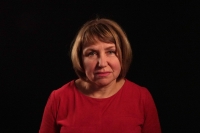I remember that exact moment when I came to a physical education class, and that happened. Someone among the girls told me, “Chornobyl exploded.” Well, I didn’t know what Chernobyl was, what exploded, or what it [meant]. But, like, it was bad. So, we spent the whole day on that sports field. I remember how it felt that day. I can’t say it affected me in any particular way, that we were irradiated or anything. Later, I remember seeing people returning from there, and they were suffering, those cancer patients, Chornobyl people, or maybe I became aware of it only later. But at that moment, it was just: well, they’ll tell us something. Well, maybe they will tell us something scary. — And did your parents say anything about it at home? Did the adults talk about it among themselves? — Well, my mom understood because she [worked at] the sanitary station; she knew what it was about. But they probably couldn’t openly discuss it even in that sanitary service. So, they must have taken some measures, things we didn’t even understand. I remember that we didn’t go to open areas for some time. My mom was always very aware of the environmental situation in Kramatorsk. Even when we bought a summer house, she knew where the wind patterns were, to avoid anything coming from the factories. So somehow… I heard about it at school, maybe on TV. And those films, and what they showed on TV. Later, in 2014, I had this, how to say it, a déjà vu, I guess? I was driving to work, and the streets were empty, grass and bushes taller than a person, dogs running back and forth. And no people, I was driving down an empty street, and I thought, “Chornobyl! This is like Chornobyl, just like what they showed about Chornobyl. It was like how it was for us in [20]14.” Our store never closed even once, and I drove to work from the village in the suburbs by car. And I remember how it was then, how the wind carried all that grass. And that grass grew, it grew. It’s always mowed down, all cleaned up. Nowadays, it’s also cleaned up — they’re always doing something, planting flowers, keeping things tidy, the city always pays a lot of attention to this. And for me, it was such a picture, that déjà vu, and I thought, “Look, just like Chornobyl, exactly.” That’s how I felt at that moment. But back then, during Chornobyl, I listened like everyone else. I can’t say it impacted me as much as it did people in Kyiv or elsewhere. And, as I understand, that cloud, it wasn’t radioactive; it didn’t affect us as much as it did other cities.








